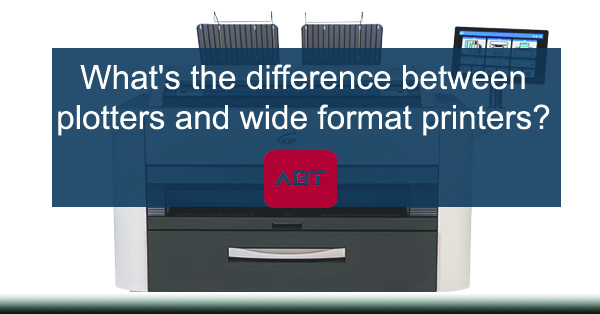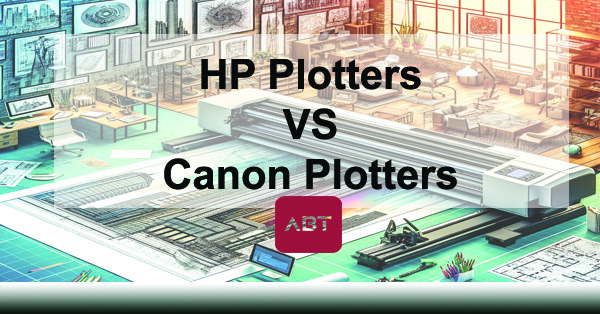
What’s the difference between plotters and wide format printers?
When it comes to understanding the office equipment you need, sometimes the details can be a little confusing. We thought it might be nice to break it down, to help you understand which devices are the most valuable for your business. We start with the basics…
Are plotter printers and wide format printers the same thing?
Plotter printers and wide format printers are often mentioned in the same breath, particularly in contexts where large-scale printing is the focus, such as in architectural firms, engineering departments, or advertising agencies. Despite their shared application in printing large items, there are distinctive differences between the two, each catering to specific needs within the broad spectrum of large format printing.
Understanding these differences is crucial for businesses, especially those in Colorado, where industries ranging from construction and engineering to marketing and design require precision and efficiency in large-scale print outputs.
What are Plotter Printers? | Precision Meets Engineering
Plotter printers are specialized devices designed primarily for printing vector graphics. Unlike traditional printers that print images line by line, plotters draw images using a pen, allowing for exceptional precision and detail. This makes them the go-to choice for applications requiring high accuracy, such as CAD drawings, architectural plans, and technical schematics.
Plotter printers are highly valued in fields like architecture, engineering, and construction (AEC) for their ability to produce crisp lines and fine details. They can work with a variety of materials, including paper, Mylar, and vinyl, offering versatility for different project needs. Plotter printers are distinguished by their method of operation:
- Pen Plotters: The traditional form of plotters, using a pen to draw on the surface of the material.
- Inkjet Plotters: A more modern iteration that combines the precision of traditional plotting with the versatility and color range of inkjet technology.
What are Wide Format Printers? | Versatility in Printing
Wide format printers, on the other hand, are designed to print large visuals such as banners, posters, and graphics for retail signage. They support a wide range of materials, including paper, canvas, fabric, and more, making them incredibly versatile. Wide format printers are typically inkjet devices that can print both text and graphics, making them suitable for a broad spectrum of applications beyond technical drawings, from marketing materials to large-scale photographs and decorative prints.
These printers are essential for businesses needing to produce eye-catching marketing materials, retail store displays, or any creative print that exceeds the standard A3 paper size. Wide format printers excel in delivering vibrant, high-quality color prints, which are crucial for capturing attention in a competitive landscape.
Key Differences
The primary differences between plotter printers and wide format printers lie in their functionality, intended use, and the type of output they produce:
- Precision vs. Versatility: Plotters are unparalleled in precision for technical drawings, while wide format printers offer versatility in printing a wide range of large-scale visuals.
- Material Compatibility: While both can handle various materials, plotters are more focused on precision materials like vinyl and Mylar, whereas wide format printers excel with a broader range of media including canvas and fabric.
- Application: Plotter printers are indispensable in engineering and architectural applications for their detailed output, whereas wide format printers are more aligned with marketing, advertising, and creative projects due to their ability to produce vibrant, large-scale images.
For businesses in Colorado, where the demand for both detailed technical drawings and striking marketing materials is high, understanding the distinction between plotter printers and wide format printers is essential. Whether it’s a construction firm needing accurate architectural plans or a marketing agency creating bold campaign materials, choosing the right printer can significantly impact the quality and effectiveness of the output.
Navigating the nuances between these printers highlights the importance of aligning your printing technology with your specific business needs. It’s not just about having the ability to print large; it’s about choosing the right tool that aligns with the precision, material, and application requirements of your projects.
Whether you’re in the market for a plotter printer or a wide format printer, ensuring it meets your business’s unique demands will help foster success in Colorado’s diverse and dynamic business environment.

And now that we have a better understanding on the differences, let’s look at the devices
When comparing large format printers like the HP DesignJet, Canon’s imagePROGRAF PRO, and the KIP 700 series, it’s crucial to consider both their technical specifications and their suitability for different vertical use cases. Each brand and series brings unique strengths to the table, tailored for specific professional environments, from architectural and engineering firms to graphic design studios and advertising agencies.
Let’s explore the specifics of each printer to understand their optimal applications and create a comparative chart for a clearer overview.
HP DesignJet Series
Specifications:
- Printing Technology: Thermal inkjet
- Maximum Resolution: Up to 2400 x 1200 dpi
- Media Handling: Wide range, including rolls and sheets up to 44 inches wide
- Ink System: 4 to 12 ink cartridges, depending on the model, including colors and blacks for detailed gradations and accurate color reproduction
Use Cases:
- Architecture and Engineering (A&E): With its precision and high resolution, the DesignJet is ideal for detailed CAD drawings, blueprints, and maps.
- Graphic Design: Supports high-quality photo prints and large color graphics with vibrant colors and deep blacks.
Canon imagePROGRAF PRO Series
Specifications:
- Printing Technology: Inkjet
- Maximum Resolution: Up to 2400 x 1200 dpi
- Media Handling: Broad media support, including glossy, matte, and fine art papers up to 60 inches wide
- Ink System: 12-color LUCIA PRO pigment ink set for a broad color range and enhanced print longevity
Use Cases:
- Photography and Fine Art: Exceptional for reproducing high-resolution photographs and art prints with precise color accuracy and detail.
- Advertising and Retail: Ideal for creating striking posters, POS displays, and retail signage with vibrant colors and excellent fade resistance.
KIP 700 Series
Specifications:
- Printing Technology: LED
- Maximum Resolution: 600 x 2400 dpi
- Media Handling: Specializes in printing on bond paper, vellum, and film up to 36 inches wide
- Ink System: Monochrome LED printer, focusing on high-speed output and efficiency
Use Cases:
- Construction and Manufacturing: Highly efficient for producing technical drawings, schematics, and site plans where speed and volume are key.
- Public Sector and Education: Suitable for printing educational materials, plans, and notices in environments where high-speed output of monochrome documents is prioritized.
Comparative Chart
| Feature/Use Case | HP DesignJet | Canon imagePROGRAF PRO | KIP 700 Series |
| Printing Technology | Thermal Inkjet | Inkjet | LED |
| Max Resolution | Up to 2400 x 1200 dpi | Up to 2400 x 1200 dpi | 600 x 2400 dpi |
| Media Handling | Rolls/sheets up to 44 inches | Glossy, matte, fine art papers up to 60 inches | Bond paper, vellum, film up to 36 inches |
| Ink System | 4-12 ink cartridges | 12-color LUCIA PRO pigment ink | Monochrome LED |
| Architecture & Engineering | Highly Recommended | Suitable | Recommended (monochrome) |
| Graphic Design | Recommended | Highly Recommended | Not Suitable |
| Photography & Fine Art | Suitable | Highly Recommended | Not Suitable |
| Advertising & Retail | Suitable | Highly Recommended | Not Suitable |
| Construction & Manufacturing | Suitable | Suitable | Highly Recommended |
| Public Sector & Education | Suitable | Suitable | Highly Recommended |
This chart illustrates the nuanced differences between these printers, highlighting how each is tailored to specific professional needs. The HP DesignJet and Canon imagePROGRAF PRO series are versatile options for high-quality, color-intensive printing applications, such as graphic design, photography, and advertising. In contrast, the KIP 700 series focuses on speed and efficiency in monochrome printing, making it ideal for sectors like construction, manufacturing, and the public sector, where volume and speed are crucial.
The choice between these printers depends largely on the specific needs of your business or project. Factors to consider include the type of documents you’re printing, the desired print quality and color accuracy, media compatibility, and, of course, the budget. Each printer series offers unique advantages for different vertical markets, and understanding these can help you make an informed decision that best suits your Colorado business’s needs.
The More You Know
Choosing between the HP DesignJet, Canon’s imagePROGRAF PRO, and the KIP 700 series depends on your specific business needs. For precision and versatility in both technical and general large-format printing, the HP DesignJet series is a standout choice. If your focus is on unparalleled color accuracy and print quality, especially for photographs and fine art, Canon’s imagePROGRAF PRO series is unrivaled. Meanwhile, for businesses prioritizing efficiency and cost-effectiveness in high-volume printing scenarios, the KIP 700 series offers compelling advantages.
The intricacies of selecting the ideal large-scale printer for your business, from the precision-driven HP DesignJet, through the vibrant capabilities of Canon’s imagePROGRAF PRO, to the high-efficiency KIP 700 series, it’s clear that making the right choice is critical to your success. This journey from understanding to action is pivotal.
It’s here that ABT steps in as your guide and partner. We understand that each business in Colorado has unique needs, from the detailed accuracy required in architectural plans to the eye-catching vibrancy needed for marketing materials.
Choosing the right printer is more than a technical decision—it’s a strategic move towards enhancing your operational efficiency and elevating your project outcomes.
ABT invites you to experience the difference firsthand. Reach out to us for a personalized demonstration, where you can see the capabilities of these printers in action. This is your opportunity to ask questions, explore the possibilities, and find the perfect match for your business’s specific needs. Let us help you navigate this crucial decision, ensuring that your investment not only meets but exceeds your expectations.
Embrace the future with confidence, knowing that every print reflects your commitment to quality and precision. Contact ABT today, and let’s take the first step towards optimizing your printing capabilities together.
